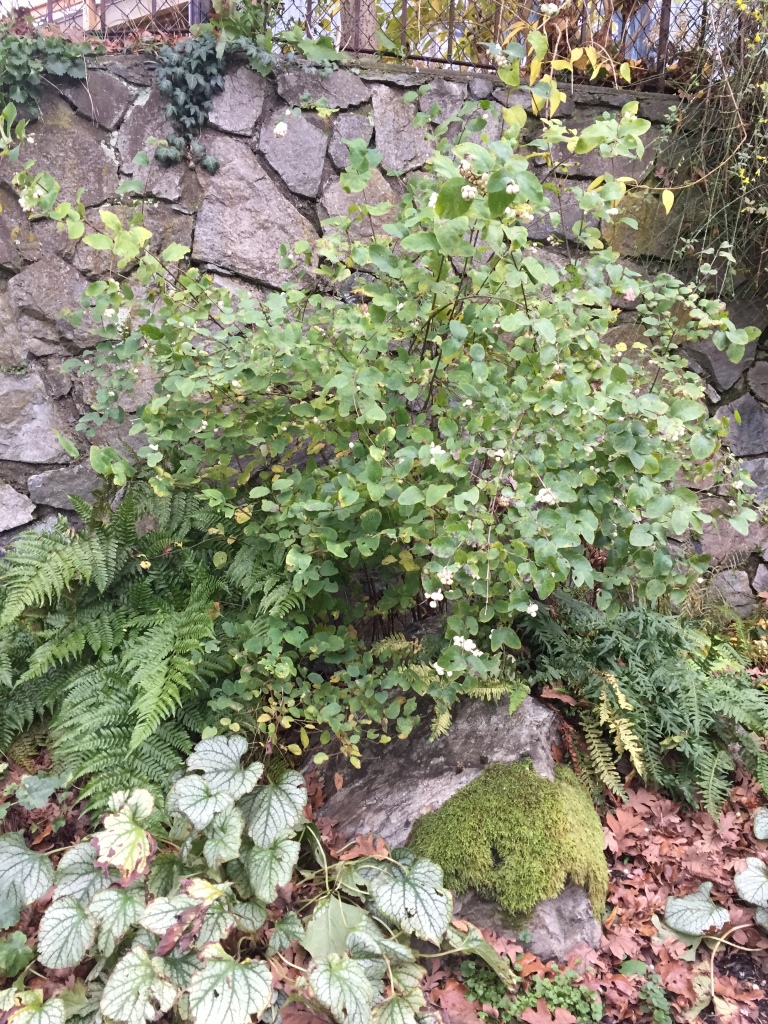The simple addition of the word ‘Common’ before a plant name seems to make it less desirable, doesn’t it?
Who would want a common plant in a garden? Don’t we all want flash – bling — the unusual? In truth, the backbone of a great many gardens is made up of ‘Common ‘ plants. It’s the common plants that enhance the flash & bling of unusual ones.
Common Snowberry seems an insignificant deciduous shrub, but it has qualities that raise its value in a garden.
- ‘Common’ basically means: it can grow pretty much anywhere.
- Here on the southern tip of Vancouver Island, where our challenge is summer drought & winter wet, Symphoricarpos albus still thrives.
- Have you got a steep yard where your hedge struggles because it’s dry at the top of the slope & soggy lower down? Snowberry handles that broad spectrum. It also handles sheering if you’re after a tidy, dense form. AND It supplies a nice cohesive look dotted throughout a mixed hedgerow.
- How about that difficult dry, shady patch where it’s tough for plants to survive? Yup, snowberry handles that, too.
- It grows well in the feast or famine water supply of bioswales & rain gardens that are so prized for slowing stormwater runoff.
- Because its vigorous roots spread via suckers, snowberry is a workhorse in erosion control, which is why it’s also recommended for restoration sites.
- Snowberry has unusual fruits.
- White berries are not the norm — and the snowberry is even more unusual in that it’s NOT even a berry! It’s a ‘drupe.’ Each fruit contains 2 ‘nutlets’ — just like the fruit of a cherry contains a pit. Cool, eh? How many folks at the garden club can you entertain with that trivia?
- Symphoricarpos albus’ bitter drupes persist late into the winter, providing welcome food for birds when other supplies run low.
- This small shrub was considered interesting & decorative enough that a couple centuries ago, it was imported by Britain & grown in many fashionable gardens. Side note: It’s become so comfortable there that it spread into their wilderness areas, too! See — it’ll grow pretty much anywhere.
- Snowberry is a native plant that welcomes wildlife to the garden.
- The diminutive pink flowers in early summer are especially appreciated by native pollinators & other beneficial insects. Both the Anna’s & Rufus hummingbirds compete for access to the blooms.
- Deer & other ungulates browse on snowberry, but it isn’t tasty enough to be gorged on as their dessert.
- Even in its naked winter state, a Symphoricarpos albus thicket provides protection, food & shelter for small birds & mammals.
I used to think snowberry was a pretty dull little shrub, but I’ve since changed my mind. A couple of years ago, I planted one in our little woodland border. Without any further attention, the snowberry survived last summer’s drought & this year, it bore fruit– several puffy white drupes. 🙂
Now the plan is to introduce it into a couple other challenging spots. The wildlife will be happy if it flourishes. If its vigorous roots spread too far, I’m sure the deer will help keep it in check.
-30-






